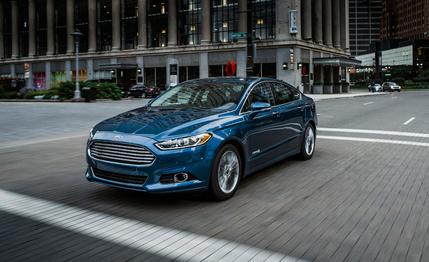2013 Ford Fusion Hybrid
You Belong to the City: Detroit makes a hybrid with real-car refinement and style.

When we tested the 2010 Ford Fusion hybrid against its blended-power brethren (Toyota Camry hybrid, Nissan Altima hybrid, and the weak-sauce “mild-hybrid” Chevrolet Malibu) in early 2009, we gave the nod to Ford, noting that the company “hit all the marks with this hybrid...” This was not a lie. But neither was it the whole truth.
True, the Ford achieved the best fuel efficiency over our 300-mile test. And true, it was the only one among the four that we claimed had “car-guy soul.” With the first Fusion hybrid, Ford sailed happily past the hybrid king, Toyota, in the race toward normal-car drivability. And it did so using a style of hybrid powertrain made familiar by Toyota. That this variety of blended gas/electric propulsion was conceived by neither Toyota nor Ford, but by aerospace giant TRW back in the late ’60s is probably not material to our business here. But now you know.
The problem with the “hit all the marks...” line is that, for all its soul, the first Fusion hybrid was an almost entirely left-brain exercise. Oh, its styling was tidy enough, we suppose, but save for the huge horizontal bands of chrome on its nose that lent it an odd sort of character, the Fusion looked like Standard Sensible Sedan, 1B.
Now have a look at the 2013 Ford Fusion hybrid (indeed, any new Fusion). Nice, right? When we gathered a gaggle of conventionally powered family sedans together last month, we inadvertently re-created the Nixon-Kennedy debate. Those who read the story know that the Honda Accord took the win. But if you looked at only the pictures, it’s likely that all you saw was the Fusion. Even as one of three silver cars in that four-car comparison, the Fusion’s Aston Martin–like grille and long, lean profile stole the show.
The Fusion now draws our car-ignorant neighbors from their houses to check out this ritzy sedan. Blend that with a hybrid system that was already a winner and what could possibly go wrong?
Well, not much, really.
One could complain that the new Fusion hybrid is slower than the car it replaces. Yes, you read that correctly. The previous model got to 60 mph in a respectable 8.5 seconds on its way to a 16.5-second quarter-mile run. The new car drops about a half-second in both measures (9.1 and 17.0 seconds, respectively). That puts the new Fusion hybrid further off the acceleration benchmark set by the 2012 Toyota Camry hybrid (7.3 and 15.7 seconds) than the old one.
|
|
The slackened pace is not likely to be a major demerit with prospective customers who surely aren’t expecting a drag racer. And the Ford Fusion hybrid doesn’t feel especially slow.
It’s not that the new Fusion hybrid, bigger in every dimension than the car it replaces, is a fatty. At 3682 pounds, our well-equipped test car was actually 123 pounds lighter than the previous-generation car we last tested. The issue is that with this go-round, Ford rebalanced the hybrid driveline’s power/economy equation. Out went the 156-hp, Atkinson-cycle 2.5-liter four-cylinder of the previous effort. In its place rests the more fuel-efficient Atkinson-cycle 2.0-liter making 141 horsepower that’s 15 pounds lighter than the 2.5. Total-system power drops from 191 horsepower to 188.
The other major equipment change to the powertrain is a trunk-mounted lithium-ion battery pack, which replaces a similarly situated nickel-metal-hydride pack. Ford took advantage of lithium-ion’s greater power density not to increase the capacity of the pack, which is down slightly from 1.5 kWh to 1.4 kWh, but to shrink its size and weight. The old unit weighed 150 pounds and formed a tall wall tucked up against the backs of the rear seats. No fold-down rear seats in that car. The new pack weighs 106 pounds, opens up a bit more trunk space, and allows for folding rear seats.
Continued...



 TEST NOTES: The available traction is more than enough to handle all that the hybrid powertrain has to offer at launch, so wheelspin is not an issue. To fully charge the battery between launches, put the car in park and depress the gas pedal.
TEST NOTES: The available traction is more than enough to handle all that the hybrid powertrain has to offer at launch, so wheelspin is not an issue. To fully charge the battery between launches, put the car in park and depress the gas pedal.